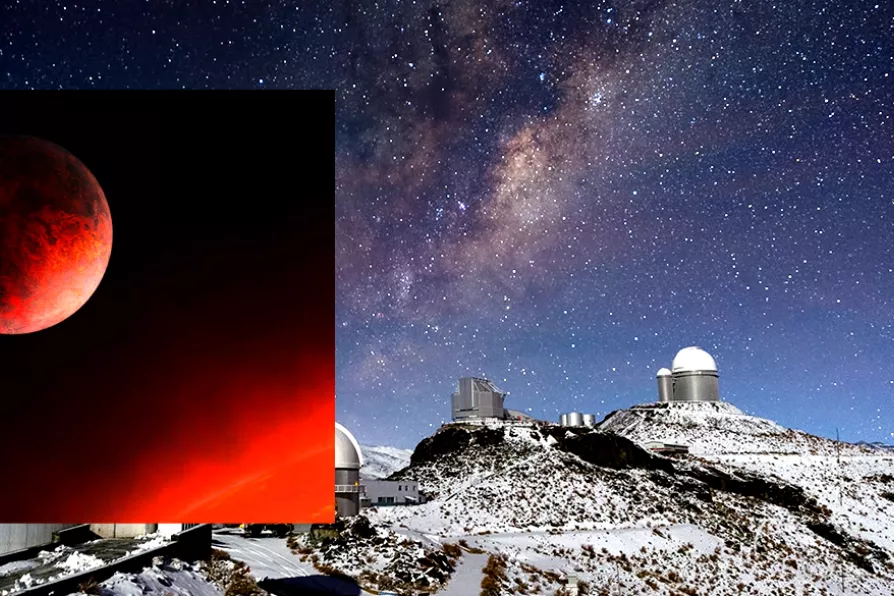KATE CLARK recalls an occasion when the president of the Scottish National Union of Mineworkers might just have saved a Chilean prisoner’s life

 FLAWED ACCESS TO THE STARS: (L to R) Artist impression of Planet GJ 367and ESO’s La Silla Observatory at the Atacam Desert in northern Chile
FLAWED ACCESS TO THE STARS: (L to R) Artist impression of Planet GJ 367and ESO’s La Silla Observatory at the Atacam Desert in northern Chile
AN international team of researchers have identified a small planet orbiting a star 31 light years away. The planet is extremely dense. One described it as “a Mars-sized planet that has the composition of Mercury.”
The researchers used a neural network model to predict the most likely composition of the planet, given the characteristics they could measure about it. The planet, named GJ 367b, orbits its star with a period of under eight hours — its “year” lasts less than one Earth-day.
Detailed observations of the light coming from the star as the planet moves past it allow the researchers to infer details on the size and composition of GJ 367b, despite never “seeing” the planet themselves. To finish with, the researchers used a neural network model to predict the most likely composition of the planet, given its measured characteristics.
Intriguingly, this suggested that it was nearly as dense as pure iron and very hot. This might be evidence that it was once a larger planet with an iron core and an outer mantle around it, but that at some point in the past the mantle was lost, leaving just a small core like the final layer of a gobstopper.
This is a fascinating observation. Following the flow of information from the initial discovery through to the scientific paper illustrates how modern astronomy works within historical structures. The romantic image of an astronomer working on their own, gazing up at the stars through a telescope they made, is totally wrong.
Observational astronomers today must collaborate and coordinate across networks to obtain the right data for their question. They need access to expensive telescopes that no individual could ever afford.
The team’s discovery of GJ 367b occurred in a search for suitable candidate stars: what scientists sometimes call a “fishing expedition.” All stars with a planet transiting in front of them — that is, when viewed from Earth — will have a periodic dip in their brightness every time the planet goes round. These “blips” show up in sky surveys. A Nasa-funded satellite with a telescope and camera monitors the brightness of stars over time and records it for analysis.
The satellite observed one particular star referred to as GJ 367b in February and March 2019, recording images every two minutes. This initial data suggested a transit signal that occurred with a regular period slightly less than eight hours. This was interesting enough for further analysis with a more powerful telescope — one based on the ground.
The team of researchers then requested time on a telescope. Telescopes are run by large organisations and astronomers must make their case to be allowed observing time, based on some preliminary data or ideas.
The particular telescope they wanted to use was located in Chile, located in the La Silla observatory on the edge of the Atacama desert. Why would a telescope be located here? At an altitude of 2,400m above sea level, and far away from light pollution, the conditions there are ideal for ground-based astronomy. The telescope is operated by the European Southern Observatory (ESO): an organisation made up of 16 European member states which operates observatories and telescopes in the southern hemisphere.
The idea for the ESO came about in the 1950s, when European astronomers decided they wanted telescopes in the southern hemisphere. In a contingent quirk, many of the interesting regions of the night sky are only visible from the southern hemisphere, thus effectively ruling them out to astronomers from the global North. As the ESO’s official webpage puts it, “twelve leading astronomers from six European countries: Belgium, France, Germany, Britain, the Netherlands and Sweden gathered in the Senate Room of Leiden University” to discuss the idea.
Over the following decade, sites were purchased. After an initial focus on South Africa, the ESO turned its focus to the Chilean Andes. Not out of disgust with South African apartheid — but because of better climactic conditions in Chile. In 1964, the Chilean government sold some land, historically occupied by indigenous people, to the ESO.
The sum paid was low, according to the ESO’s positive spin reflecting “the interest on the part of the Chilean government in having the observatory established.” (The implication that the ESO could — and probably should — have paid more is not mentioned.)
Returning to the star GJ 367b: the astronomers got time to use the telescope in June 2019. They observed GJ 367b on three consecutive nights in June 2019, each time observing it for about 2.5 hours. This gave them even better data on the transit signal.
They then backed up these observations with yet more observations from another ground-based telescope, this time at Siding Spring Observatory in Australia, operated by the Australian government.
After analysing this data, GJ 367b was observed on January 10 2020 by an instrument on the Gemini South telescope. Gemini South is also in Chile, but at a different location to La Silla. It is funded by a consortium including the US, Canada, Chile, Brazil and Argentina. While international astronomers are aware of the problems that you get when wealthy countries control telescopes in poorer countries — for example, some efforts do exist to give time to researchers from poorer countries on those telescopes — it’s clear evidence of how science is shaped by global politics.
All of these telescopes and hours of observing time produced data that fed into the final paper. We mentioned earlier that astronomers must usually request telescope time. In astronomy, telescope time is a precious resource. There are far more requests than availability — for the ESO, researchers each year make requests which add up to between 4-6 times as many nights as there are in a year. To choose between these requests, organisations have reviewers — other astronomers — who decide which project they think is most deserving of time to carry out their observations.
Recent data about telescope requests shows that often they are deciding who they think is most deserving, based on the person more than the idea.
In 2018, Nasa changed the system for requesting time on its Hubble Space Telescope, in orbit around the Earth. Under the new “double-blind” system, neither requester nor reviewer knows who the other is. Since the change, there have been marked increases in the number of successful requesters who have never had any observation time before. This suggests that previously your name mattered more than the science. The data suggest that the effect has been to reduce gender bias, although this data isn’t as public or clear as the “first time observer” effect.
The story of GJ 367b shows how international an enterprise science is, how it rests on complex historical legacies, and how biases shape scientific research. There will be many other interesting things out there in the universe. Some of those we haven’t seen, not because somebody hasn’t wanted to look, but because they haven’t been given permission to do so.

The distinction between domestic and military drones is more theoretical than practical, write ROX MIDDLETON, LIAM SHAW and MIRIAM GAUNTLETT

Nature's self-reconstruction is both intriguing and beneficial and as such merits human protection, write ROX MIDDLETON, LIAM SHAW and MIRIAM GAUNTLETT

A maverick’s self-inflicted snake bites could unlock breakthrough treatments – but they also reveal deeper tensions between noble scientific curiosity and cold corporate callousness, write ROX MIDDLETON, LIAM SHAW and MIRIAM GAUNTLETT
Science has always been mixed up with money and power, but as a decorative facade for megayachts, it risks leaving reality behind altogether, write ROX MIDDLETON, LIAM SHAW and MIRIAM GAUNTLETT













